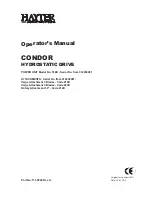
MAINTENANCE
REGULAR MAINTENANCE
This instrument does not require any regular maintenance.
On occasion, one or more of the four rear-panel fuses may require replacement. All
fuses can be accessed from the rear panel. See the “FUSES” section for details.
CLEANING
If desired, the interior of the instrument may be cleaned using compressed air to
dislodge any accumulated dust. (See the “TOP COVER REMOVAL” section for
instructions on accessing the interior.) No other cleaning is recommended.
TRIGGER DAMAGE
The rear-panel TRIG input, used in the external trigger mode, is protected by a diode
clamping circuit. However, the protection circuit is not foolproof, and it is possible for a
grossly excessive signal to damage the trigger circuitry on the main timing control
board (the 4×10 inch board on the right side of the instrument).
The IC that is most likely to fail under these conditions is installed in a socket. It is a
standard TTL IC in a 16-pin plastic DIP package, model 74F151 or equivalent.
If you suspect that this IC has been damaged, turn off the power and replace this IC. It
may be replaced by a 74F151, 74LS151, 74ALS151, or 74HCT151.
61
Summary of Contents for AVRQ-4-B
Page 41: ...41...
Page 51: ...Bottom side 51...
Page 67: ...PCB 158R5 LOW VOLTAGE POWER SUPPLY...
Page 68: ...PCB 104G KEYPAD DISPLAY BOARD...
Page 69: ...PCB 228C OP AMPS AHV AND XHV UNITS...
Page 71: ...DUT WIRING ON STANDARD DAUGHTERBOARD PCB 267D...
Page 72: ...DUT WIRING ON SO 8 DAUGHTERBOARD PCB 314A...
Page 73: ...DUT WIRING ON WDIP16 DAUGHTERBOARD PCB 325A...
Page 75: ...PERFORMANCE CHECK SHEET 75...















































